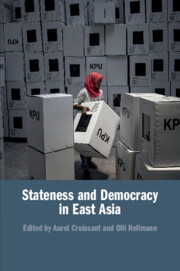Book contents
- Stateness and Democracy in East Asia
- Stateness and Democracy in East Asia
- Copyright page
- Contents
- Figures
- Tables
- Contributors
- Acknowledgements
- 1 Introduction: Rethinking Stateness and Democracy in East Asia
- 2 State-Building and Democratization
- 3 South Korea’s Democracy and the Legacies of the Developmental State
- 4 After Hegemony: State Capacity, the Quality of Democracy and the Legacies of the Party-State in Democratic Taiwan
- 5 Democratization Interrupted: The Parallel State and the Demise of Democracy in Thailand
- 6 Weak State and the Limits of Democratization in Cambodia, 1993–2017
- 7 The Institutional Roots of Defective Democracy in the Philippines
- 8 Stateness and State Capacity in Post-Authoritarian Indonesia: Securing Democracy’s Survival, Entrenching Its Low Quality
- 9 As Good as It Gets? Stateness and Democracy in East Timor
- 10 Stateness and Democracy: Evidence from East Asia and Cross-Regional Comparisons
- Index
- References
8 - Stateness and State Capacity in Post-Authoritarian Indonesia: Securing Democracy’s Survival, Entrenching Its Low Quality
Published online by Cambridge University Press: 13 May 2020
- Stateness and Democracy in East Asia
- Stateness and Democracy in East Asia
- Copyright page
- Contents
- Figures
- Tables
- Contributors
- Acknowledgements
- 1 Introduction: Rethinking Stateness and Democracy in East Asia
- 2 State-Building and Democratization
- 3 South Korea’s Democracy and the Legacies of the Developmental State
- 4 After Hegemony: State Capacity, the Quality of Democracy and the Legacies of the Party-State in Democratic Taiwan
- 5 Democratization Interrupted: The Parallel State and the Demise of Democracy in Thailand
- 6 Weak State and the Limits of Democratization in Cambodia, 1993–2017
- 7 The Institutional Roots of Defective Democracy in the Philippines
- 8 Stateness and State Capacity in Post-Authoritarian Indonesia: Securing Democracy’s Survival, Entrenching Its Low Quality
- 9 As Good as It Gets? Stateness and Democracy in East Timor
- 10 Stateness and Democracy: Evidence from East Asia and Cross-Regional Comparisons
- Index
- References
Summary
This chapter discusses the stateness-democracy linkage in Indonesia’s post-1998 democratization process. While the stateness developed under authoritarianism appeared to erode after 1998, a robust democracy was nevertheless established. This surprising outcome raises the question of what the precise role of stateness and its related capacities was in establishing and maintaining the democratic regime after 1998. Did the capacity developed under Suharto survive the collapse of the authoritarian regime in 1998 and help to create the conditions under which democracy was entrenched, together with its deficiencies? Or did democracy develop new state capacities that allowed the country to consolidate? There is evidence, this chapter argues, that the core of Indonesian state capacity entrenched under Suharto endured during the transition, assisting in the creation of an electoral democracy. Yet, the deals that post-authoritarian rulers had to enter into in order to access that state capacity trapped Indonesia in low-quality democratic rule. There is also evidence that, although low in quality, Indonesia’s democracy strengthened some of the state’s capacities, while it failed to impact others.
- Type
- Chapter
- Information
- Stateness and Democracy in East Asia , pp. 179 - 203Publisher: Cambridge University PressPrint publication year: 2020
References
- 1
- Cited by



